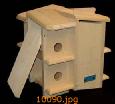Need For
Birdhouses
One of the
favorite birds of people who are not necessarily serious students of other
types of bird is the Purple Martin. This friendly fellow returns the
affection by preferring to live around humans.
The Purple
Martin (Progne subis)has been lovingly housed by many for nostalgic
reasons -- their grandparents and parents had martin houses. And
this bird, for whom everyone watches eagerly in the spring, comes back to
his established home year after year.
But the
martin is a species which needs humans for a number of reasons. Many
factors, such as insecticide spraying, have contributed to a reduction in
their number, and martins need our help in removing such deadly threats.
Young martins have a high mortality rate (more than 75% of fledgling
martins die during their first year of life). And 50% of adults die each
year. They are particularly vulnerable to bad weather, to starvation, and
to extreme heat. They have several natural predators, including snakes,
raccoons, cats, squirrels, hawks, and owls, which raid their nests, and
competing birds who nest in their houses if given the opportunity
(particularly House Sparrows and Starlings).
A Purple
Martin landlord cannot simply erect a martin house, sit back, and enjoy
watching his new colony of graceful birds swooping through the air in
pursuit of insects. He (or she) must diligently fend off the
competition and predators, clean out any sparrow nests, clean out the
martin nests at the end of the season, and plug the entrance holes for the
winter.
If he is
undaunted in this role of landlord, the martin will reward his efforts,
filling his birdhouses each year with family upon family of this
delightful aviary companion and devouring a wide variety of insects flying
about his yard.
A Purple
Martin will range over an area of about four square miles. He drinks fresh
water only, dipping down to catch a drink "on the wing." His house may be
as close to or as far away from other martin houses as his landlord
desires; he has no preference in this matter.
Martins
need a source of calcium, and martin lovers may place crushed eggshell or
oyster shell nearby for the birds. The eggshell should be washed
first to eliminate any bacteria.
Martins
may move into a new home the day it is put up, or it may take ten years
for them to nest in it.
Attracting Purple Martins
To attract
Purple Martins to a birdhouse, the house should be placed in an open
space, at least 40 to 60 feet from any trees taller than it is, preferably
within a few hundred feet of human habitation. The birds need a wide space
to approach the house from at least two sides, and they seem to know that
people will protect them from their natural predators. The activity of
people does not seem to bother them at all.
The house
should be mounted 10 to 20 feet off the ground, preferably on a
telescoping pole so that it can be lowered for easy cleaning and for
checking on the young in the nests. A predator guard on the pole is also
highly desirable. The house should not be moved, once martins have taken
up residence in it, as they will reject it the following year if it is in
a new location.
If any
other species of bird nests in the martin house before the martins arrive,
the house will not attract martins. This may involve frequent, even daily,
lowering of the house to evict unwanted tenants, or plugging the entrance
holes until the martins arrive.
The houses
which are most successful in attracting martins are of a light color. This
helps to keep the house cool in the summer's heat and highlights the dark
entrance holes. Ventilation holes also keep the birds from perishing on
hot days.
The
birdhouses should not be opened up until about four weeks after the first
martins are scheduled to arrive in the area. The first to arrive,
commonly called "scouts," are not really scouts, but are merely the oldest
martins. Older martins cannot be attracted to new locations, because
they have high loyalty to the exact home where they bred in the
past. Usually only the previous year's fledglings can be attracted
to unestablished sites, and they begin returning to an area about 4 to 5
weeks after the "scouts."
Bushes and
shrubs growing beneath the martin house should be removed, as this
attracts predators such as cats, and martins will avoid the house.
Similarly, they will avoid houses which can be reached by squirrels, even
by a wire.
A landlord
probably cannot have too many martin houses, as most places will support
several hundred breeding pairs per square mile. And, while Purple
Martins live on flying insects, there is no scientific data to show that
mosquitoes form a significant portion of this diet.
A "colony"
of Purple Martins consists merely of more than one breeding pair in a
given house. They are not necessarily related to each other.
back to top...





 Coveside Purple Martin House
Coveside Purple Martin House
 Coveside Wood Chips Nesting Material
Coveside Wood Chips Nesting Material
 Woodside Gardens
The Registry of Nature Habitats
Woodside Gardens
The Registry of Nature Habitats 
 1999 -
1999 -
